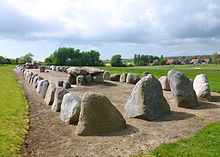Megalithic bed of Wulfen
The giant bed of Wulfen in the south of Fehmarn in Schleswig-Holstein is a replica made in 2010.
On the Wulfener Berg, near Wulfen, there was a burial ground with large stone graves of the funnel cup culture (TBK) from the time from 3500 to 2800 BC. Several long beds with a length of up to 130 m were striking (these giant beds are among the longest in Germany). In 1836, the archaeologist Diederich Harries (1791-1857) described the largely destroyed graves, of which no traces can be found. The stones were blown up and sold as building material.
The model for the replica of the long bed was a drawing made by D. Harries of a long bed that was in good condition at the time and that lay on the salt marsh below the Wulfen mountain. It consisted of an east-west facing edging and two chambers, each with seven bearing stones and two cap stones. This megalithic complex was destroyed in 1876 when stones were needed to build the dike.
The stones used for the approx. 60 m long and 7.0 m wide replica were gathered all over Fehmarn and erected with the help of excavators. A so-called sacrificial stone was placed in the middle of the grave, but it does not fit into this context. The hill overhanging, which was common in the Stone Age, was dispensed with, as was the intermediate masonry in the gaps between the stones.
Web links
- Description and picture. (PDF; 1.5 MB) Retrieved July 18, 2015 .
- Nicole Rochell: A long bed as a destination. June 6, 2010, accessed July 18, 2015 .
- Video
Coordinates: 54 ° 24 ′ 19.4 " N , 11 ° 9 ′ 44.6" E
